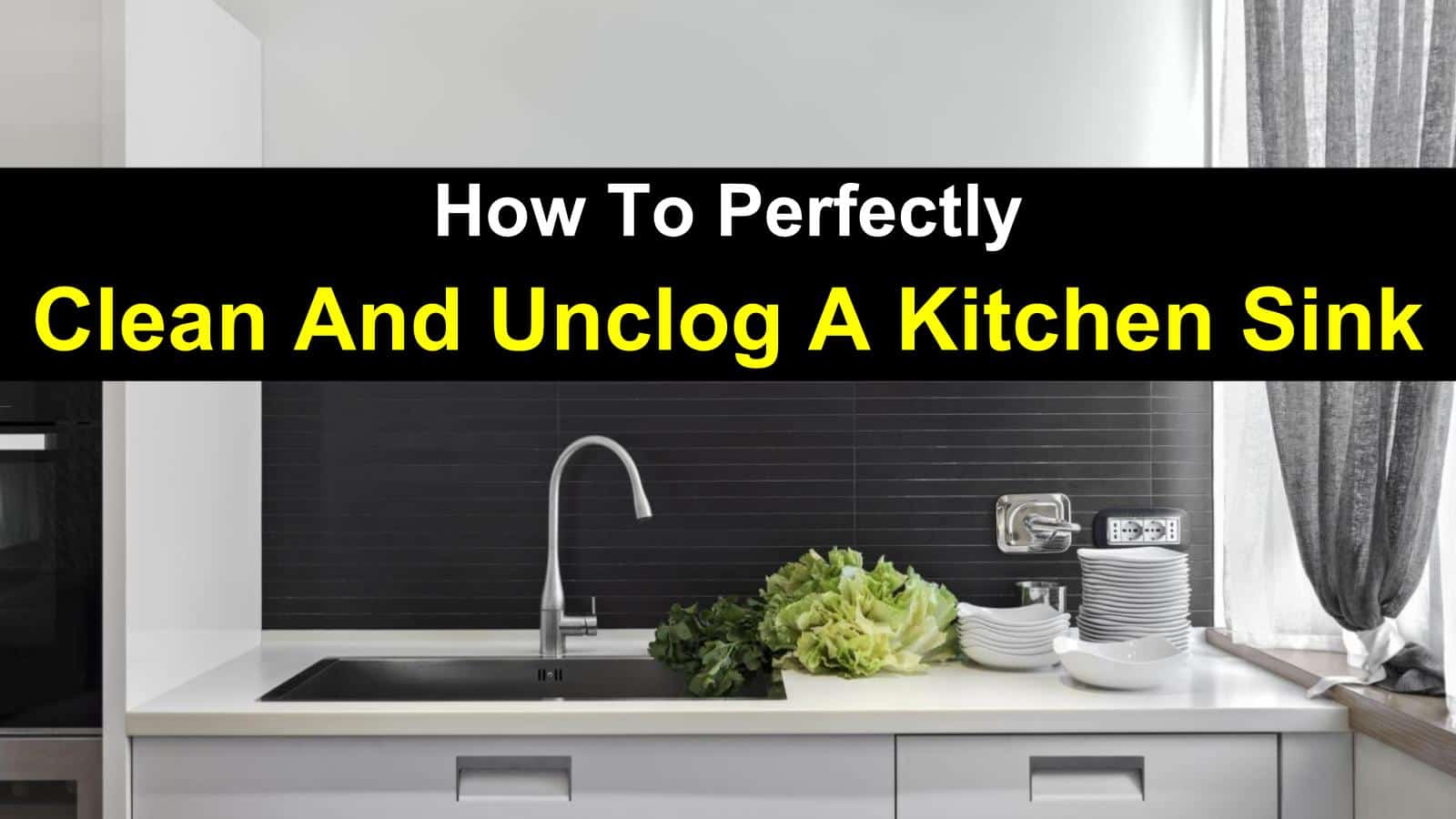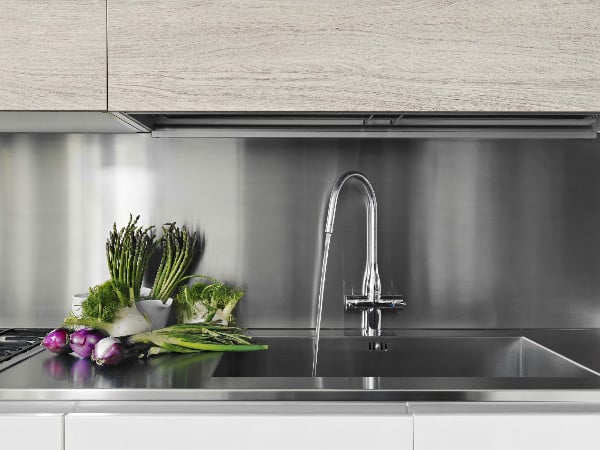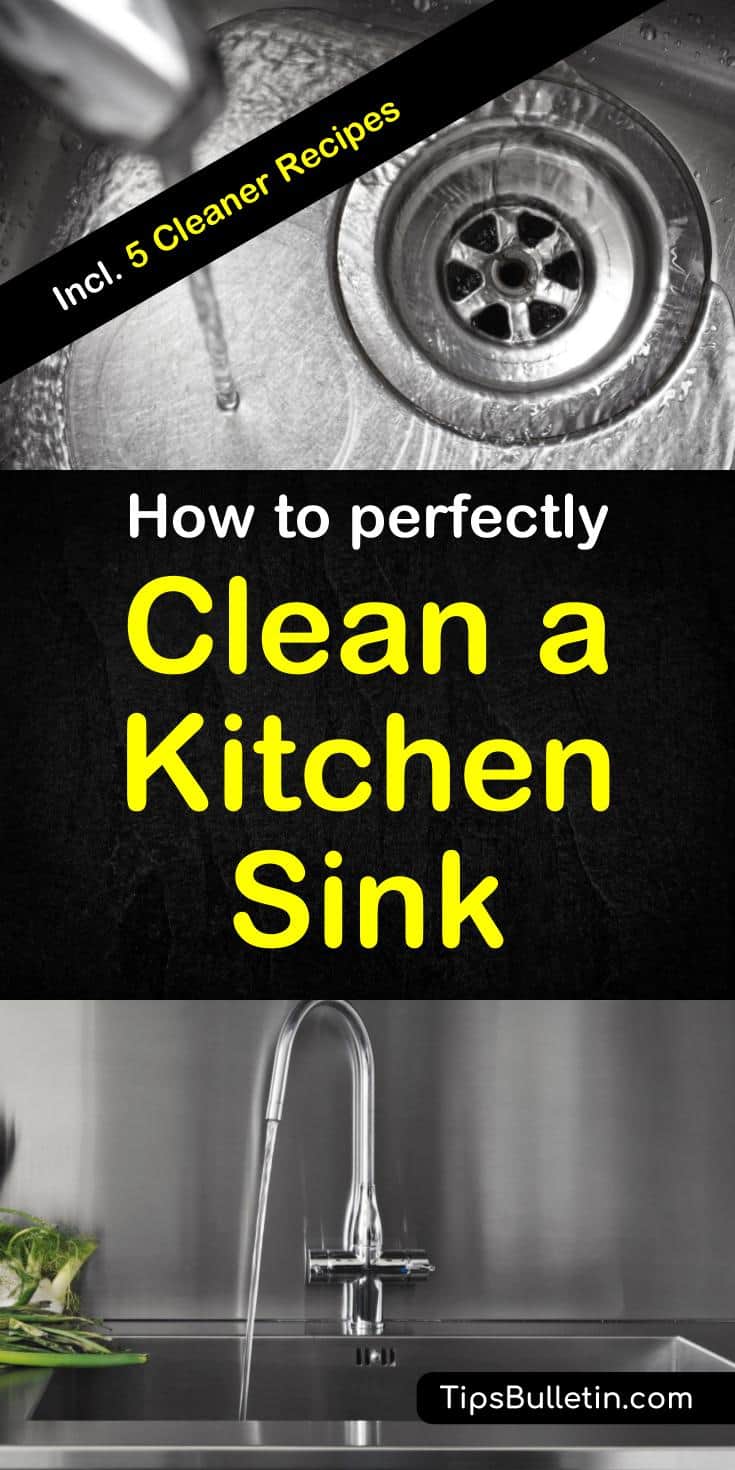Sinks: they’re such a familiar sight, you may overlook just how much you use them. Thirsty? Get a glass of water from the sink. Have a pile of dirty dishes? Toss them in the sink and give them a good scrubbing. So, it is crucial to learn how to clean a kitchen sink properly if you want to keep yours in good condition.
Did the kids just come in from a day of playing, covered in dirt? Send them to the kitchen to wash their hands before dinner (just make sure to know how to wash a kitchen sink when they’re done!).
People often use sinks for much more than just doing dishes, and because of this, they are especially prone to getting dirty, scuffed, scratched, clogged, or developing odors from the wide variety of debris they collect. You probably already have the ingredients you need to deodorize the garbage disposal and sink without using harsh chemicals.

You probably use few appliances as much as the kitchen sink, but do you know how to clean one properly? You can easily make a DIY kitchen cleaner for your sink and the other well-used surfaces in the kitchen.
You’re also going to learn how to clean a sink drain that has an unpleasant smell and how to unclog a kitchen sink so that water continues to flow smoothly through the pipes.
How to Clean a Kitchen Sink
Despite how much soap we use in them, kitchen sinks can get dirty too! However, the type of sink impacts how you clean it. The following tips can help you clean the unique material of your kitchen sink.

How to Clean a Porcelain Sink
Porcelain sinks are common in many older homes and can also add a vintage flair to more modern kitchens. However, porcelain is extremely susceptible to chips, cracking, and discoloration.
There are certain cleaners that are ideal for using as a porcelain sink cleaner and others that can harm it so choose your cleaning solution carefully. Better yet, make your own!
For weekly cleaning, use this homemade kitchen sink cleaner to take care of stains and make your sink shine again. The best way for how to remove stains from porcelain is to mix the dish soap with hot water and gently scrub on the surface of the sink with a soft sponge or a dishrag.

For deeper cleaning or to remove stubborn stains that simple wiping will not handle, mix ammonia and baking soda to create a powerful cleaning solution that is safe to use on porcelain or other types of sinks, too.
To remove stains from porcelain sink, scrub the stained areas with a non-abrasive sponge and this cleaner, rinsing, and repeating as necessary. Make your kitchen brighter with a spotless sink.
How to Clean a Granite Sink
Granite sinks are beautiful and durable, but many household cleaners are too harsh to be used in granite sinks. Mild dish detergent will clean your sink and granite countertop; using a non-abrasive sponge, gently scrub the surface of the granite sink, rinsing with warm water.
For more in-depth ways to clean a granite sink and get rid of unsightly stains, you can try a paste made from baking soda and water. Repeat applications may be required.
Use a clean soft cloth to dry the surface before applying a thin layer of olive or mineral oil. Like all our other DIY granite countertop cleaner recipes, the oil helps to restore the shine of granite while also protecting the stone. Clean your sink this way once a week to keep the granite looking like new.
How to Clean a Copper Sink
The care for and clean your copper sink will often depend on whether it has a patina finish. For sinks with a patina finish or those with a weathered or aged appearance, maintenance is as easy as washing it with a mild dish soap any time the sink looks dirty. The soapy water will do miracles and keeps your sink sparkling longer.
After cleaning tarnished copper or taking care of unsightly spots, be sure to apply a high-quality wax designed for plumbing features as extra protection, especially in areas with hard water. Because copper is naturally antibacterial, no further cleaning or harsh chemicals are needed.
How to Clean a Stainless Steel Sink
Stainless steel sinks are incredibly durable but can quickly lose their shine.
To keep your stainless sparkling, start by rinsing any grime or food particles with warm water. Next, sprinkle the sink with baking soda and gently scrub it in; the baking soda is non-abrasive and will not scratch the surface of the sink.
Rinse the sink with white vinegar, which will cause the baking soda to bubble and fix as it disinfects. After rinsing one final time with water, rub the surface with a lemon or orange peel to leave behind a fresh, citrus scent.
In addition to cleaning your sink, this recipe is ideal if your kitchen sink smells like sewage. The combination of baking soda, lemon, and vinegar eliminate unpleasant smells in the drain while leaving your sink nice and shiny.
DIY Ways to Clean Your Garbage Disposal
If you have a garbage disposal to get rid of small food debris that accumulates in the sink, garbage disposal cleaning should take place as often as the rest of your sink. Cleaning and sharpening the blades on your garbage disposal can keep it running smoothly and help it work well for years to come.
Sanitizing the interior of your garbage disposal is an important part of overall kitchen cleaning and helps to eliminate unwanted odors that may develop from leftover pieces of food in the disposal. If your dishwasher is not operating properly or if your dishwasher smells really bad, you may have a blockage in your garbage disposal, as the pipe system is connected.
Try to unclog a dishwasher first by removing the blockage in the disposal. You may be able to solve both problems at once. The following DIY tips can help you clean your garbage disposal at home without purchasing chemical cleaners.
Citrus Peels

Next time you peel an orange or eat grapefruit, don’t throw the peels in the trash. Instead, use them as a homemade garbage disposal cleaner. Put the citrus peels down the garbage disposal and run them through with water.
See more on this organic drain cleaning solution here. Not only will the citrus create a pleasant smell, but the oils from the peels can also help coat and protect the blade.
Ice Cubes

Running ice cubes through the garbage disposal is one of the most effective methods for sharpening the blades. For more effective cleaning power, consider freezing a mixture of water and vinegar or adding rock salt to the ice.
Create Disposal Refreshers
While garbage disposal refreshers are available at many stores, it is also possible to make your own at home! You’ll need baking soda, salt, liquid dish soap, and the juice and zest of one lemon.
Mix all ingredients until the mixture resembles coarse sand. Next, scoop and shape spoonfuls of the mixture onto a piece of parchment paper, allowing them to dry overnight.
The homemade tablets can be dropped into the garbage disposal as needed to clean and refresh it! It has never been easier to clean and freshen your garbage disposal.
How to Cleana Smelly Drain
Food odors can linger in your sink long after they have gone down the garbage disposal. The most common causes of kitchen sink odors are food particles trapped beneath the garbage disposal blades or those that settle in the p-trap. This decomposing food can cause unpleasant odors if left in the plumbing. Here’s how to clean a smelly drain.
One of the quickest and easiest ways to clean out a sink drain naturally and deodorize the p-trap is with baking soda and warm water. Pour the soda down the drain, rinsing with the water. The baking soda can deodorize the drain while also killing any bacteria causing the odors.
For sinks with a garbage disposal, putting ice cubes in the disposal should help clean the blades and loosen any trapped food particles.
For day to day maintenance, leave the garbage disposal on under running water for at least 20 seconds every time you use it. You can also use one or more of these household products for cleaning a smelly dishwasher.
Putting vinegar or lemon juice in a dishwasher-safe dish and running the machine empty will do wonders to get rid of distasteful smells. Also, cleaning out the filter gets rid of food debris that can cause odors.
How to Unclog a Kitchen Sink – Without Calling the Plumber
A clogged kitchen sink can disrupt your ability to use your kitchen. Believe it or not, similar to how to unclog a shower drain, you can unclog a kitchen sink without usingchemicals or calling the plumber. Here’s a home remedy for a clogged drain.
You’ll find that one of the most effective ways to clean a clogged sink is by creating a baking soda and vinegar drain cleaner volcano. You’ll need bake soda, white vinegar, water, and a pot.
For cleaning kitchen sink drains, pour boiling water down the drain to loosen any hardened buildup. Next, dump the soda into the drain; follow this immediately by a mixture of vinegar and one cup of hot water. Plug the drain to contain the bubbly reaction and let sit for five to ten minutes.
Finish by flushing the drain one last time with a pot of boiling water to rinse it clean of any residual debris. Baking soda volcanoes are extremely efficient at unclogging sinks for numerous reasons. First, the boiling water loosens any hardened particles or sludge in the pipes.
The combination of bake soda and vinegar creates a bubbly reaction that jolts the clogs loose while also helping to neutralize odors. Lastly, pouring a second potof boiling water in the drain washes away any remaining particles.
You can also use this simple recipe for cleaning a bathroom sink drain. Accumulation of toothpaste, hair, and other gunk can block proper water flow in your bathroom sinks. Try a baking soda volcano on sinks in the bathroom to leave all your sinks smelling fresh and flowing smoothly.
A Clean Sink is a Happy Sink
Whether it’s your first time learning how to clean a kitchen sink or you’ve been struggling through unsuccessful cleaning for years, be sure to try these methods. You’ll find they will work for you every time. You may even have some fun!
In this article, you learned how to clean a kitchen sink, how to clean a smelly drain, and how to unclog a kitchen sink.

Know someone who could benefit from tips on cleaning sinks? Use the buttons below to share to Facebook, Twitter, and Pinterest!